Bittersweet
Sunday, 29 June 2025
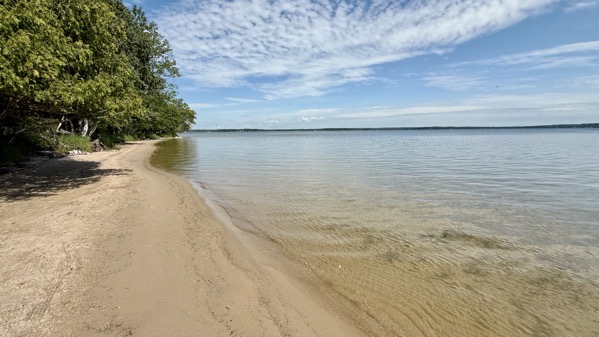
This was a sunny afternoon five days ago. I’m over a thousand miles south of this beach, no lakes or sandy shores nearby. I’m torn about relocating, but quite glad to no longer be on the road. 😅
Sunday, 29 June 2025

This was a sunny afternoon five days ago. I’m over a thousand miles south of this beach, no lakes or sandy shores nearby. I’m torn about relocating, but quite glad to no longer be on the road. 😅
Friday, 27 June 2025
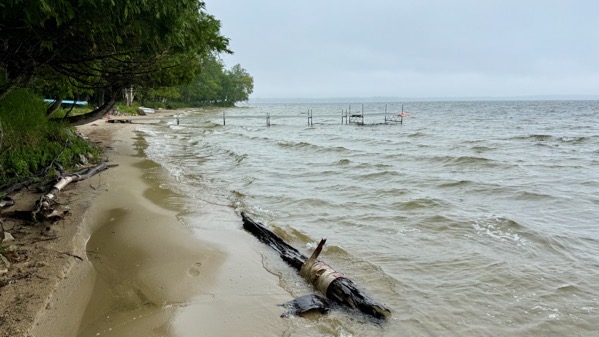
This morning’s murky sky was from moisture; in fact, it may well be raining across the lake, as the trees there are scarcely visible. BTW, this log was out in knee-deep water yesterday—shows the power of breaking waves.

These bushes are heavy with blossoms, denser than we remember from previous years. Of course, the blooms additionally are heavy with rain accumulation. I can’t remember what The Botanist called them; with a little help from plant recognition software, I’m pretty sure they are Kolkwitzia amabilis, beautybush to everyday folk.
Thursday, 26 June 2025

The storm the other day brought this lupin down across the path, and my eye was caught by the complex patterns in in the blossoms.
I can’t know, of course, but perhaps when I stopped to take this picture the seed tick I found inside my elbow a couple hours later crawled onto me…ick. I quickly removed it, then took a shower with lots of soaping, followed by a complete towel scrubbing.
Wednesday, 25 June 2025
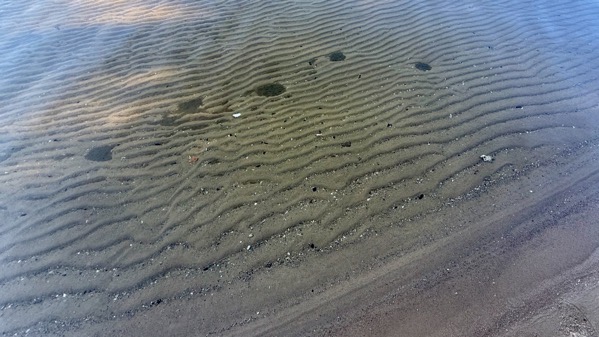
Down on the beach during my morning stroll, I could see these dips in the under-sand filled with I-dunno-what, but they are deer tracks, pretty sure.
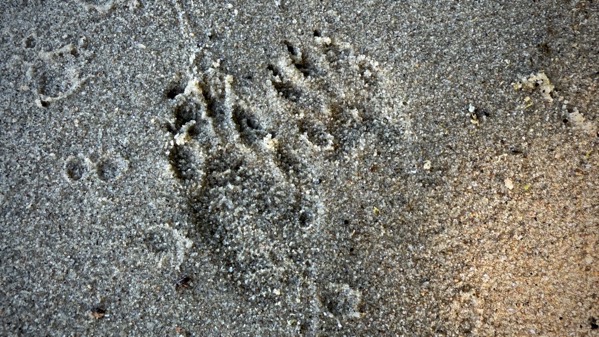
On the exposed sand, I have been seeing tracks like this for years and wondered what critter made them, with unsolved confusion. Today, perhaps, I had a break-through: not raccoon, but skunk? Going with skunk.

Up in the orchard above the beach, these bent lupins are evidence of lodging by a storm several days back. The plants have adjusted to present to the sun-sky, hence the bends.
Monday, 23 June 2025
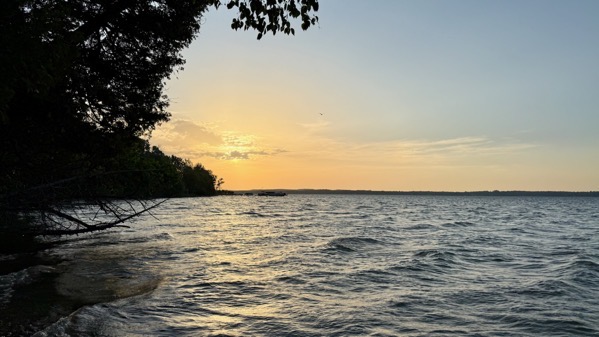
I went to the beach to see the sunrise, and caught the post-rise glow…over a slightly roily lake. It’s been at least a day of the lake being in motion, and that changes the microbiome…I found ten large leeches while walking the beach cast ashore by the relentless turbulence, and snagged them each with a stick and tossed each in the woods. Me and the wind: altering the microbiome.
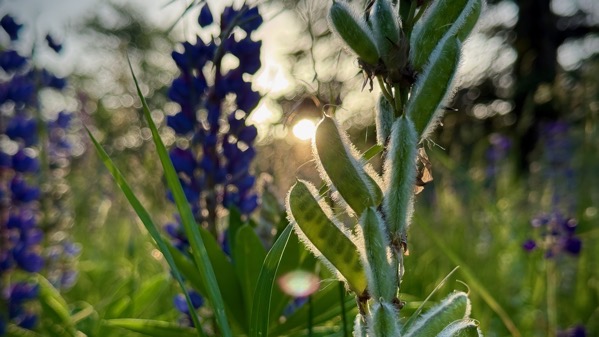
Returning to the cottage to make coffee, I spotted the sun illuminating a lupin that’s already displaying fuzzy pods.
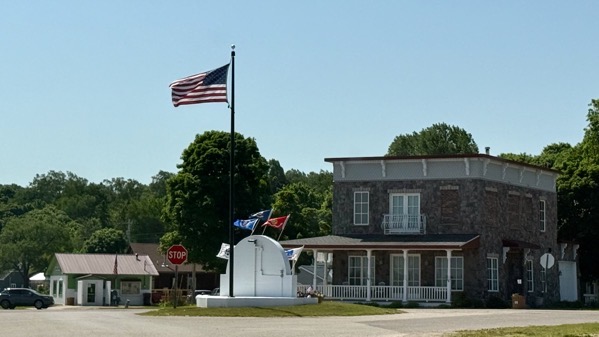
Since today was to be hothothot, even more than yesterday, we decided to visit the largest and deepest of the Great Lakes, the S of HOMES. This is the flag display standing at attention in the south (offshore) wind at Grand Marais…the Michigan one.
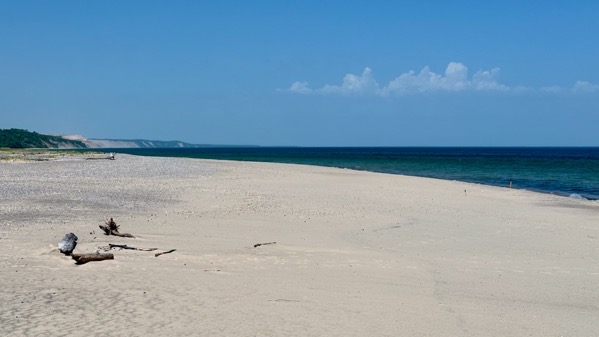
At the end of the peninsula bracketing Grand Marais’s bay, we walked out toward the lighthouse. This is looking west along the beach…you can see there’s some overcast obscuring the distant dunes. Indeed, several times at the cottage, we’ve smelled a touch of the smoke still being generated up in Canada.
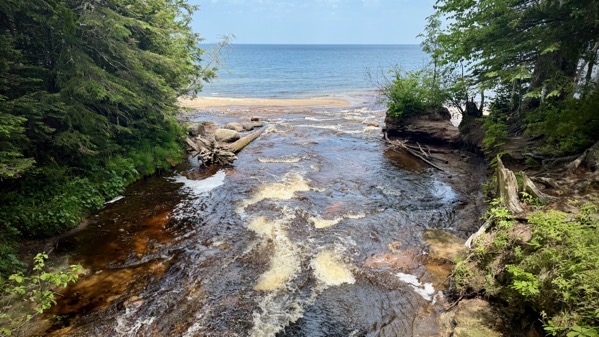
We drove west to the mouth of Hurricane River, one of our favorite stops. The offshore wind means the biting stable flies are epic in the quiet air, so we didn’t hike to the Au Sable Lighthouse as we typically do.
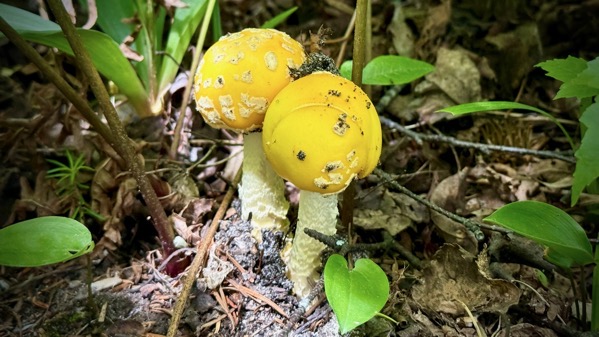
We spotted this pair of Amanitas adjacent to the along-the-beach path aka the North Country Trail…and (haha) unaffected by the biting flies…. Not so, the two of us. Back on the road, we turned up the fan to discourage the biting flies that followed us into the car…they head for the windows and the ankles…and they are per-SIS-tent (ouch; their bite is sharp).
Saturday, 21 June 2025
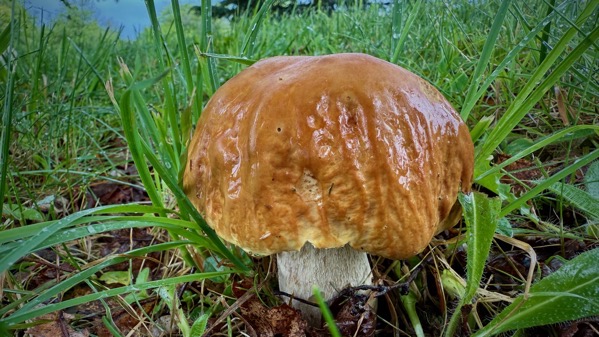
We had rain in the wee hours, then an overcast dawn-time, then a break. In that relative calm, the gulls wheeled around the cottage, then landed and strutted in the grass. They were looking for fishflies, I suspect…’tis their time of a feeding frenzy.
I found this boletus on my way to the beach during the calm.
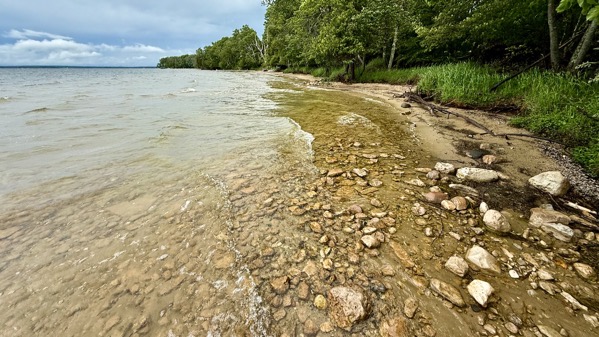
The lake wasn’t as wavy as I expected.
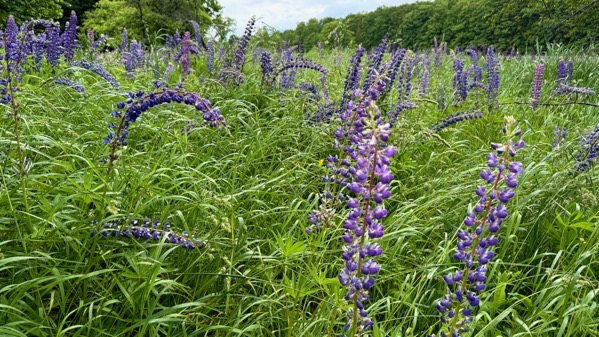
As I returned to the cottage, the wind kicked up and tipped over the lupins this way and that, when some were already bent by the overnight storminess.
Late in the afternoon, the sun came out and it got relatively warm, while still steamy. The high was 79°F, I think, so lower than predicted (we’re supposed to have an overheated weekend), because of how the overcast, etc. played out. I doubt we’ll have such relief tomorrow.
Friday, 20 June 2025
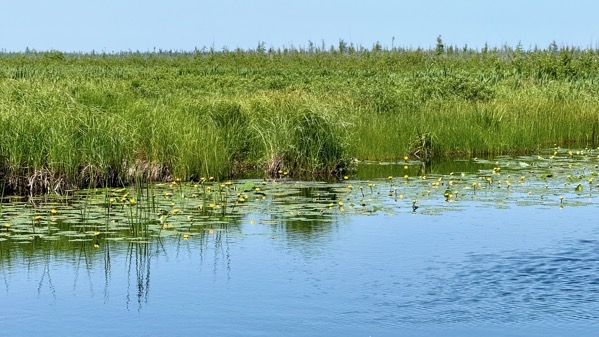
We took a wee side trip to stare into Tahquamenon River, way in the upper reaches…I estimate only some 15% of the catchment is upstream of this spot—for whatever it’s worth. 😉
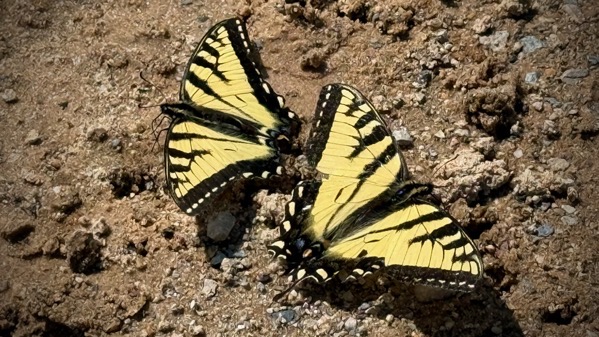
We found four of these spell-binding swallowtails (if you can tolerate butterflies) flitting about on the boat launch apron next to the bridge.
The Guru calls it Take-Home-A-Sac (sarcastic harhar).
Tuesday, 17 June 2025
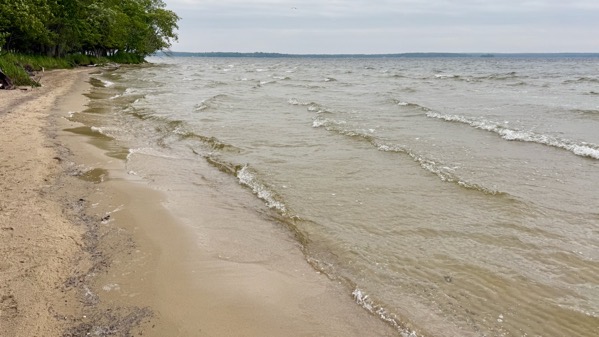
On my post-coffee beach walk, I saw wee rollers coming in, not feverishly, but unmistakably.
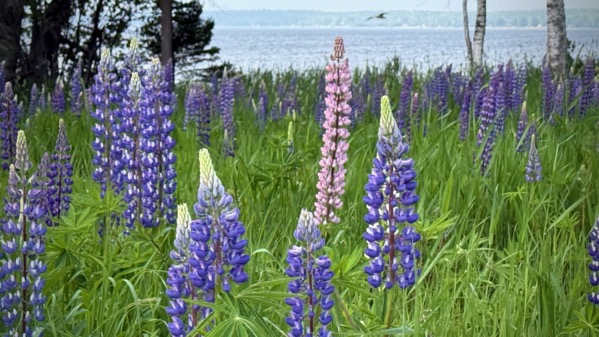
I had to post this photo with the colorful lupins and serendipitous OOF* seagull.
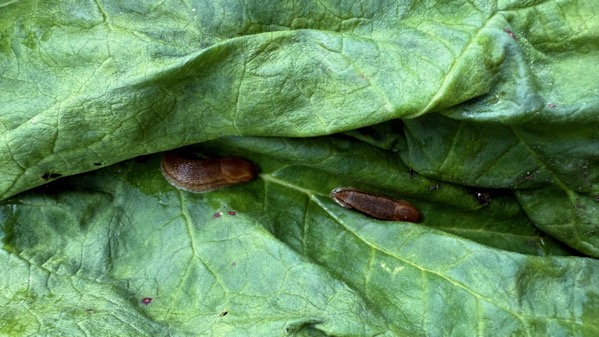
Back in the garden, I flipped open a discarded rhubarb leaf, and discovered a pair of slugs. Yup, they’re gross. But, still: nature data.
* OOF = out of focus
Monday, 16 June 2025
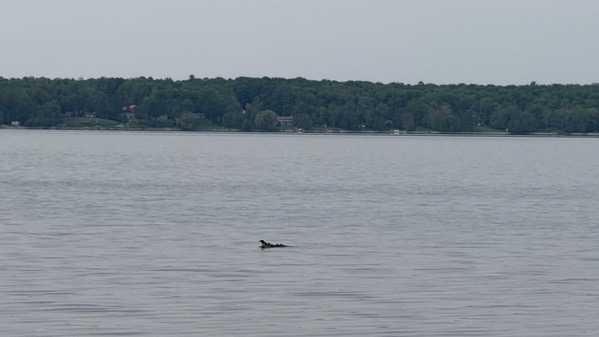
During my morning beach stroll, I spotted these offspring freeloading on mom’s back as she cruised away from a potential threat—meeeee.
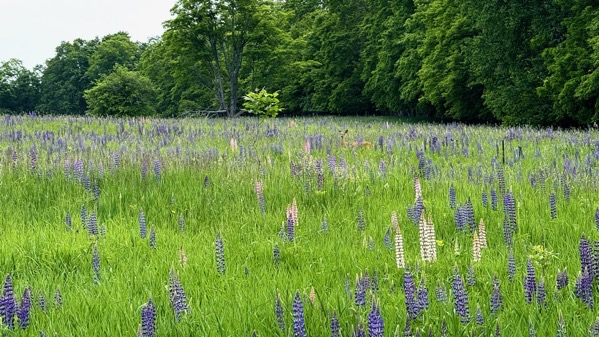
Then, up in the field, I spotted ears above the lupin (just right of center in this shot), which resolved into a doe watching me. She never moved beyond keeping her focus on me as I walked here and there, then departed. I figured she didn’t move because she was by her fawn. [Just a few minutes ago, we saw a doe-(very young) fawn combo in the orchard, which could have been this postulated pair.]
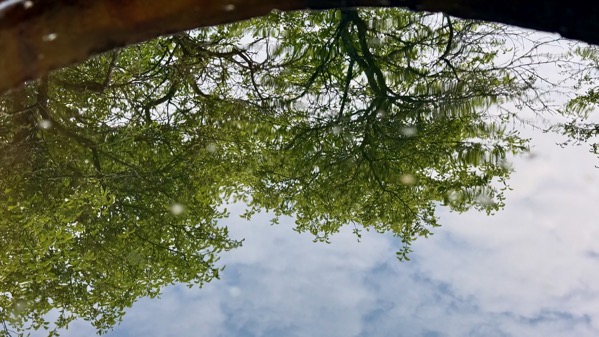
Tired of mom-stories? Here’s one of my oft-repeated water barrel reflection shots…illustrating our overcast, yet pleasant day..
Saturday, 14 June 2025
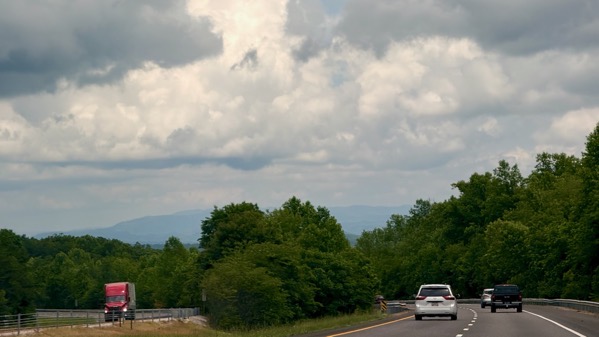
Look! Mountains are above the trees.
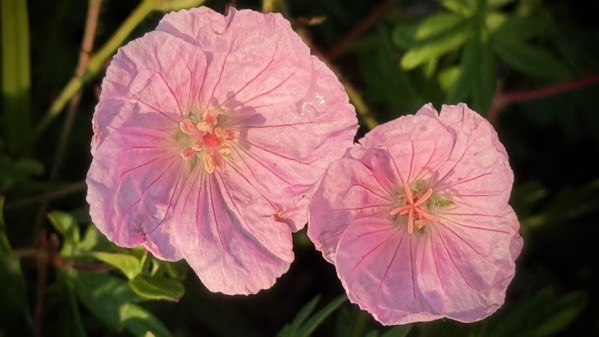
This was taken in the flatlands of old lake-bed northern Ohio, but flatlands are tough to take interesting shots of, so here’s a delicate flower, probably/perhaps a geranium of some sort.